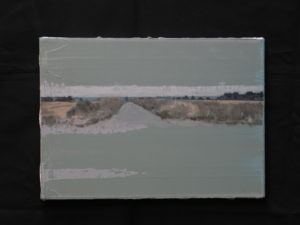As a prize at primary school I was given Adrian Hill’s What Shall We Draw? It was published in 1957. It showed you how to draw such things as horse drawn milk floats, steam driven road rollers, farm animals and trees in full leaf. Trees and animals I was familiar with. The urban stuff was obviously dated and not part of my experience. But copying other’s drawings was a strategy I adopted early on. As well as pencil drawings I made paintings using poster paints (gouache). The paint came in little individual pots from a toy shop in the town. I liked the names of the colours and collected the pots, favouring the blues.
Later I gained grade 1 CSE Art at secondary school, along with English and Music. (Secondary school was not a good time for me.) My clearest memory from art lessons from this time was learning to paint a colour wheel. I had already found out by then that I had inherited red green colour blindness from my maternal grandfather, though I didn’t understand how it might influence my use of paint.
After I left school I did not draw again until into my thirties. I used ‘Teach Yourself’ type instruction books, particularly in watercolour, to learn how to use materials. Copying continued as a basis to learn. I liked to acquire different techniques – laying a wash, scumbling paint – and constructed pictures in order to use and practice these newly learnt traditional skills – they seemed impressive. I briefly tried evening classes in art. Eventually I met a teacher who introduced me to life drawing and I worked with him, in small groups which he led, for several years. We used a wide range of materials, including oil paint which was new to me. Working with a teacher contrasted with working from books. We were led through a range of five finger exercises which stretched my visual vocabulary and opened up new possibilities to me. I was inspired and enthused. I developed a habit of keeping a sketch book with me. I also worked through two painting courses with the Open College of the Arts, which mostly involved working alone at projects from books. I developed a fairly good understanding of oil paint, both from reading about techniques and through practice. Something new that started to seep into what I was doing was an understanding that I might eventually communicate my own ideas through drawing and painting. I also began to feel frustrated by the limitations placed on me by my colour blindness, having been encouraged to look at the work of painters such as Matisse and Bonnard.
When I was forty-five I left full-time work (work incidentally was and is nursing – nothing to do with image making or art) to do a Foundation course at Norwich Art School. After that year I continued at the art school, leaving with a BA in fine art three years later. I spent most of my time there painting. Tutorials and group tutorials were sometimes useful. I often found though that in tutorials I could be put off what I was doing and be persuaded to go off in another direction, which was not necessarily right for me. I think this was because I was often unsure what I was trying to achieve and discussing it did not necessarily make it any clearer, often having the opposite effect. I seldom felt I could adequately or accurately verbalise what I was doing. I found though that by using the material of paint, even if I felt unsure of what I was doing to start with, ideas would eventually formulate. Perhaps the problem was within me. A manual on how to do this or that is more or less simple to follow, and with practice one develops a dexterity and skill in the use of whatever medium. Tutorials on the other hand were not like this. They went beyond simple techniques. They generally raised questions and did not necessarily provide answers or solutions. Another difficulty I experienced was in linking theory we studied to my own work. In the third year, with encouragement, I started to read artists’ writings and found some common ground with past practitioners, in terms of painting techniques and approaches to painting as well as ideas about composition and constructing a painting. I liked the idea of communicating with dead painters in this way, taking ideas and reinterpreting them for my own ends – another form of learning by copying. By this time I had also developed a way to work effectively within the limitations of the mild type of colour blindness I experience.
My painting bears a relationship to photographs, either found or my own. Sometimes I combine photographs and painting, but most of the time I have used photographs as a starting point for a painting. Recently I made a conscious decision to stop painting altogether and now make only photographs. I use a camera rather like a sketchbook and what I photograph tends to reflect what I am doing day to day. I like to keep it simple and make photos fairly quickly, setting the camera up to use semi-automatically, varying the settings occasionally for different effects.
Stephen Hyatt-Cross
https://www.flickr.com/photos/sh-c/
